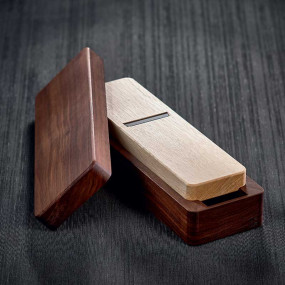What is katsuobushi?
The term "Katsuobushi" commonly refers to smoked and dried skipjack tuna. Katsuobushi can be further processed into several secondary products, each with a specific name depending on the stage and degree of its preparation.
Skipjack tuna (Katsuwonus pelamis) that has been boiled, smoked, and dried is known as arabushi. When arabushi is shaved and shaped to improve its appearance, it is called hadakabushi. Cultivating a mold (a microscopic fungus) on the hadakabushi two or more times results in karebushi.
The generic term for these products is katsuobushi.
The history of dried bonito
Since late 2013, Washoku—Japanese culinary traditions—has been recognized as an Intangible Cultural Heritage of Humanity by UNESCO, a decision warmly welcomed in Japan.
When we think of Washoku or Japanese cuisine, dishes like sushi, sukiyaki, tempura, soba, and udon often come to mind. Some dishes you regularly enjoy might be adapted versions of Japanese recipes, modified to suit local tastes.
Today, Washoku is appreciated worldwide, and the secret of its appeal lies in dashi (meaning soup stock), which serves as the foundation of many Japanese dishes, similar to broth in Western cooking.
Dashi, the cornerstone of Washoku, is made using ingredients like katsuobushi (smoked and dried bonito) and kombu (dried seaweed). In today's globalized food culture, where people consume a wide variety of foods and encounter numerous products, Japan bears the responsibility of providing accurate information about dashi and its flavors while promoting Washoku. The most popular dashi type is katsuobushi dashi, made using katsuobushi.
For centuries, Japanese people have developed a unique culinary culture where fish plays a central role, especially katsuobushi. This ingredient is made by simmering skipjack tuna in hot water, smoking it, and then drying it.
This long-lasting and flavorful ingredient has been a favorite of the Japanese for ages due to its delicious taste and excellent preservation qualities.
Why do japanese people love dried bonito and katsuobushi dashi?
Japan, an island nation blessed with abundant natural resources, developed a culinary culture centered on the bounties of the mountains, rivers, and ocean. Fish and shellfish became vital protein sources for the Japanese.
Over the centuries, the Japanese perfected their culinary skills around fish, employing a variety of preparation methods such as grilling, simmering, and drying. Among these, using katsuobushi to prepare dashi became central, establishing katsuobushi as a key ingredient in Japanese broths.
A primitive form of katsuobushi is mentioned in the Kojiki (Records of Ancient Matters), compiled in 712. At that time, katsuobushi was a valuable commodity often used as tax payment due to its long shelf life. Its production was simple, involving simmering in hot water and sun-drying.
By the samurai era, katsuobushi was carried as a battlefield ration. Around 1600, production methods evolved, with sun-drying replaced by wood smoking, creating what is now known as arabushi. By 1800, the technique of producing karebushi was developed, introducing mold cultivation on arabushi to enhance its flavor. Katsuobushi thus became a uniquely Japanese ingredient.
A classic and essential component of dashi in Japanese cooking, katsuobushi played a crucial role in the development of regional cuisines during the Edo period (1600–1868). Culturally, it was also used as an offering to deities, a symbol of good fortune, and a wedding gift, making it an integral part of Japanese customs and life.
Dried bonito and umami
Alongside sweet, salty, sour, and bitter, umami is the fifth basic taste, first identified by Japanese scientists. Today, umami is recognized globally as a distinct flavor.
Glutamic acid, an amino acid classified as umami, was discovered in kombu (dried seaweed) in 1903. In 1913, Japanese scientists identified inosinic acid, another umami compound, in katsuobushi. In 1960, it was found that awase dashi (a blended dashi made with katsuobushi and kombu) amplified umami through the interaction of inosinic acid from katsuobushi and glutamic acid from kombu.
This powerful umami interaction enhances the taste of foods even with minimal salt, confirming one reason for the Japanese preference for katsuobushi dashi.
Export and domestic production differences
Katsuobushi intended for export differs from its domestic counterpart, as it features subtler smoky notes and a more refined, elegant flavor with milder acidity. This makes it more accessible for Western cooking, where the intense smoky and fishy flavors of traditional katsuobushi might be overwhelming.
Nutritional benefits of katsuobushi
Katsuobushi is rich in nutritional value. About 20% of the human body is composed of amino acids, which are essential for muscle, organ, bone, nerve, blood, and skin formation. Katsuobushi contains all nine essential amino acids in balanced proportions.
Additionally, it is a great source of DHA (docosahexaenoic acid), crucial for cognitive development and function, and EPA (eicosapentaenoic acid), which helps prevent thromboembolic disorders like blood clots.
How to use katsuobushi in cooking
Katsuobushi comes in various forms for Japanese cooking:
Kezuribushi (shaved flakes): The most common form, sold in packets for convenient use in dashi preparation.
Powdered katsuobushi: An instant seasoning for quick dashi.
Liquid condiments: Dashi-based sauces for noodle soups or marinades.
Katsuobushi is also used as a garnish. The iconic "dancing katsuobushi" effect, seen on dishes like takoyaki and okonomiyaki, occurs when hot steam causes the thin flakes to curl and wave.
Storage tips
To preserve its flavor, store katsuobushi in an airtight vacuum-sealed package in the refrigerator. Opened packets should be consumed quickly, as exposure to air leads to oxidation and loss of aroma.
Katsuobushi is a cornerstone of Japanese culinary traditions. Despite modernized production methods, the craftsmanship of traditional artisans remains crucial to its quality. An indispensable ingredient in Washoku, katsuobushi continues to captivate chefs and home cooks worldwide.


































